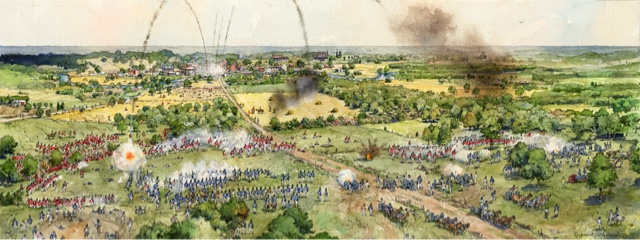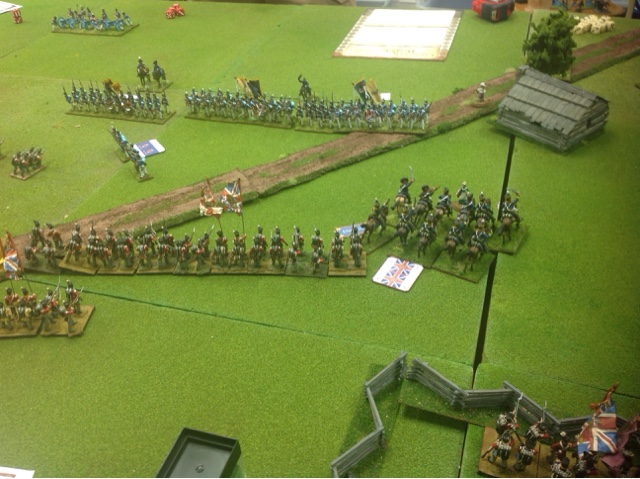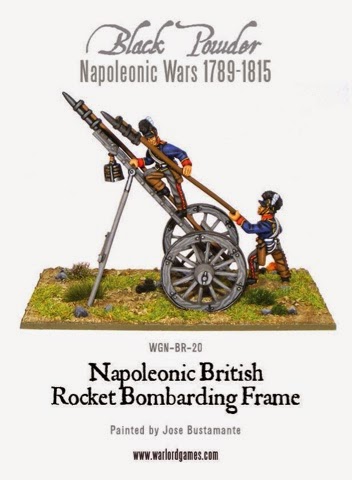The Battle of Bladensburg
August 24th, 1814
Starting Positions
*1 man = 15
2 Guns = 3 Guns
2 Guns = 3 Guns
British Army Scenario Rules
Victory Conditions; The British must rout the Americans.
1. British Infantry Shooting Bonus; British / Canadian infantry get +1 to shooting rolls when in line. Militia and Indians do not get this bonus
British Order of Battle
Major General Robert Ross (Excellent)
*The British enter the table one brigade after the other. The first brigade begins as shown on the far right, then the second brigade, then the third brigade.
1st (Light) Brigade
Colonel William Thornton (Average)
Light Companies 4th, 21st, 44th (217 men) X15 (Veteran)
Light Comp. 63, 66 +88
+1 morale
+1 morale
Can refuse a flank
+1 to shooting in line
*Entire formation can skirmish
85th (Bucks Volunteers) Regiment of Light Infantry (800 men) X30 X30 (Veteran)
+1 morale
Can refuse a flank
+1 to shooting in line
Up to 50% can Skirmish
Up to 50% can Skirmish
2nd Royal Marines Detached Company (86 men) X12 (Line)
2nd Colonial Marines (100 men)
*these were former slaves
+1 melee
+1 to shooting in line
Can deploy as skirmishers
Royal Marine Rocket Section (X2 Rockets) X2 Rockets (Veteran)
+1 Morale
Rocket Rules
-Range of 48 inches, must have line of sight, may fire overhead
Roll 2 D6
12 Direct and devastating hit. Six casualties. Consult double six table
11 – 9 Target unit lose 1 casulty and falters BUA’s set alight.
8-4 Miss
3 The nearest friendly unit to the rocket battery is hit by stray rockets and loses two casulties.
2 Rockets double back and strike ammunition. Rocket battery completely destroyed. (Rout)
Royal Marine Artillery (2 X 3 Pounders) X1 Gun (Veteran)
+1 morale
2nd Brigade
Colonel Arthur Brooke (Average)
4th (King's Own) Regiment of Foot (630 men) x40 (Veteran)
+1 morale
Can refuse a flank
+1 to shooting in line
44th (East Essex)Regiment of Foot (610 men) x40 (Line)
+1 to shooting in line
3rd Brigade
Colonel Patterson (Average)
2nd Marines (600 men) x40 (Elite)
+1 to shooting
+1 morale
+1 melee
Can refuse a flank
+1 to shooting in line
Can form open order
21st (Royal North British Fusiliers) Regiment of Foot (884 men) x32 and x32 (Line)
+1 to shooting in line
Not Engaged, Guarding the Shore
Converged Royal Marines Battalion (564 men) X36 (Elite)
+1 to shooting
+1 morale
+1 melee
Can refuse a flank
+1 to shooting in line
Can form open order
American Army Scenario Rules
Victory Conditions; The Americans must stop the British from reaching Washington.
1. Linear Tactics; Line units in the same brigade have to have the same formation except to go around terrain and other units.
2. Buck and Ball; American Regulars used “Buck and Ball”; a round shot with 3 buck shots, they get +1 to hit at close range.
3. Chosen Men; Up to 12 men maybe deployed as Chosen Men (Rifles). They roll 2D6 per 4 figures. They can form part of the skirmish screen or operate independently. They do not need to stay within 18 inches of close order units. This unit has a range of 17 inches.
American Order of Battle
William H. Winder (Poor Command)
First Line (Far Forward Left)
(Average Command)
Baltimore Rifles (150 men) x18 (Second Line)
Virginian (James City) Light Infantry (100 men)
-1 morale
This entire unit can skirmish
Baltimore Artillery (4x6 Pounders) x2 Guns (Conscript)
-1 morale
-1 melee
-2 firing modifier
Baltimore Artillery (4x6 Pounders) x3 Guns (Conscript)
-1 morale
-1 melee
-2 firing modifier
Second Line (Forward Left)
(Average Command)
5th Baltimore City Regiment 500 men x40 (Conscript)
-1 morale
-1 melee
-2 firing modifier
1st Baltimore Militia (675 men) x40 (Conscript)
-1 morale
-1 melee
-2 firing modifier
2nd Baltimore Militia (675 men) x40 (Conscript)
-1 morale
-1 melee
-2 firing modifier
Baltimore Artillery (3x6 Pounders) x2Gun (Conscript)
-1 morale
-1 melee
-2 firing modifier
Cavalry *Independent Unit
(Average Command)
Maryland District Cavalry 260 men (Conscript) x21
4 Companies Maryland Cavalry
DC Alexandria Dragoons 40 to 50 men
-1 morale
-1 melee
4 Companies Maryland Cavalry
DC Alexandria Dragoons 40 to 50 men
-1 morale
-1 melee
Third Line
Left
Scott (Regulars) Smith (DC Militia) (Average)
12th / 36th / 38th US Infantry (400 men) x30 (Line)
+1 to shooting at close range
1st DC Militia (535 men) x42 (Conscript)
-1 morale
-1 melee
-2 firing modifier
2nd DC Militia (535 men) x42 (Conscript)
DC Detachments (200 men)
-1 morale
-1 melee
-2 firing modifier
DC Rifles: 3 Companies (330 men) x18 (Conscript)
-1 morale
-1 melee
-2 firing modifier
This whole formation can skirmish
Washington Irish Artillery (6 6 Pounders) x4 Guns (Conscript)
-1 morale
-1 melee
-2 firing modifier
DC Militia Artillery (6 6 Pounders) x4 Guns (Conscript)
-1 morale
-1 melee
-2 firing modifier
Centre
U.S. Flotilla Servicemen (200 men) x24 (Veteran)
U.S. Marines (120 men)
+1 morale
+1 to shooting at close range
Naval Guns (18 and 12 Pounders x5 Guns) x3 Guns (Veteran)
+1 morale
Right
Annapolis Militia (800 men) x24 and x30 (Conscript)
-1 morale
-1 melee
-2 firing modifier
Reserve
Maryland Militia (250 men) x24 (Conscript)
-1 morale
-1 melee
-2 firing modifier
Reserve Cavalry *Independent Unit
Colonel Jacinct Laval (Average Command)
2nd Light Dragoons (140 men) x16 (Second Line)
Virginia Militia Dragoons 100 men
-1 morale
-1 melee
Reinforcements *Arrive turn 15
60th Virginian (700 men) x24 and x24 (Conscript)
*Arrived late and out of ammunition
-1 morale
-1 melee
-2 firing modifier





















































